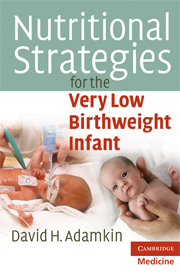Book contents
- Frontmatter
- Contents
- Acknowledgement
- Foreword
- Glossary
- 1 Introduction
- 2 Fluid and electrolyte management (Na, Cl and K)
- 3 Energy
- 4 Intravenous carbohydrates
- 5 Intravenous lipids
- 6 Early total parenteral nutrition (TPN)
- 7 Parenteral calcium, phosphorus, magnesium, and vitamin D
- 8 Parenteral vitamins
- 9 Trace elements and iron
- 10 Parenteral nutrition guide
- 11 Parenteral nutrition-associated cholestasis in VLBW infants
- 12 Enteral nutrition
- 13 Enteral feeding guidelines practicum
- 14 Optimizing enteral nutrition: protein
- 15 Human milk
- 16 Premature infant formulas
- 17 Standard infant formulas
- 18 Soya formulas
- 19 Protein hydrolysate formulas
- 20 Enteral calcium, phosphorus, magnesium, and vitamin D
- 21 Iron
- 22 Hypercaloric feeding strategy
- 23 Growth in the neonatal intensive care unit influences neurodevelopmental and growth outcomes
- 24 Nutritional assessment
- 25 Post-discharge strategies
- 26 Nutritional management of preterm infants with short bowel syndrome
- 27 Summary
- Index
7 - Parenteral calcium, phosphorus, magnesium, and vitamin D
Published online by Cambridge University Press: 05 August 2012
- Frontmatter
- Contents
- Acknowledgement
- Foreword
- Glossary
- 1 Introduction
- 2 Fluid and electrolyte management (Na, Cl and K)
- 3 Energy
- 4 Intravenous carbohydrates
- 5 Intravenous lipids
- 6 Early total parenteral nutrition (TPN)
- 7 Parenteral calcium, phosphorus, magnesium, and vitamin D
- 8 Parenteral vitamins
- 9 Trace elements and iron
- 10 Parenteral nutrition guide
- 11 Parenteral nutrition-associated cholestasis in VLBW infants
- 12 Enteral nutrition
- 13 Enteral feeding guidelines practicum
- 14 Optimizing enteral nutrition: protein
- 15 Human milk
- 16 Premature infant formulas
- 17 Standard infant formulas
- 18 Soya formulas
- 19 Protein hydrolysate formulas
- 20 Enteral calcium, phosphorus, magnesium, and vitamin D
- 21 Iron
- 22 Hypercaloric feeding strategy
- 23 Growth in the neonatal intensive care unit influences neurodevelopmental and growth outcomes
- 24 Nutritional assessment
- 25 Post-discharge strategies
- 26 Nutritional management of preterm infants with short bowel syndrome
- 27 Summary
- Index
Summary
Recommendations for mineral and vitamin D intake for preterm infants are based on metabolic studies with the goal being optimizing bone and mineral homeostasis associated with normal serum minerals and vitamin D metabolites and, most important for the VLBW infant, normal bone density.
The molar Ca:P ratio is 1.3 in the whole body and 1.67 in the bone mineral apatite. Ninety-seven percent of whole body calcium and 80% of whole body phosphorus are stored in the apatite together.
Serum calcium exists in three fractions: ionized calcium (∼50%), protein-bound calcium (∼40%), and a small amount of calcium that is complexed, primarily to citrate and phosphate ions. Serum calcium is maintained at a constant level by the actions of principally parathyroid hormone and calcitonin.
In the presence of low phosphate intake the kidney retains phosphate and it disappears from the urine. Hypercalcemia and hypercalciuria may result from phosphate deficiency. Deficiency of phosphate results in bone demineralization and osteopenia of prematurity. Calcium is actively transported across the placenta in the third trimester of gestation; thus an infant born in the third trimester, especially early in that trimester, is born relatively osteopenic and strategies to maintain calcium homeostasis are of paramount importance.
TPN for VLBW infants typically provides minerals to meet about 60–70% of intrauterine mineral requirements. Early TPN when reaching volumes of 120–130 mL/kg/d contains calcium at 60–90 mg/kg/d, phosphorus at 47–70 mg/kg/d, magnesium at 4.3–7.2 mg/kg/d and vitamin D at 40–160 IU/kg/d (Table 7.1). VLBW infants on TPN for longer duration (> two weeks) should receive an approximate 33% increase in calcium and phosphorus concentration in their infusate.
- Type
- Chapter
- Information
- Publisher: Cambridge University PressPrint publication year: 2009

